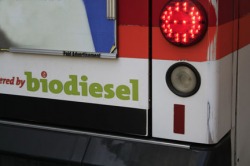EcoMerge - Fuel Savings
Alternatives

We have chosen to focus on "Micro-Fuel Savings" because it is a simple way for people to incorporate fuel saving ideas into any budget. However, we recognize that some of our audience may want to compare these ideas with other options that may involve a more drastic change or possibly the purchase of a new vehicle. Therefore, we have included the below information with appropriate links for your benefit, enjoy!
DIESEL VEHICLES

Diesel vehicles may be making a comeback. Diesel engines are more powerful and fuel-efficient than similar-sized gasoline engines (about 30-35% more fuel efficient). Plus, today's diesel vehicles are much improved over diesels of the past.
Better Performance Improved fuel injection and electronic engine control technologies have:
Cleaner
Today's diesels must meet the same emissions standards as gasoline vehicles, and advances in engine technologies, ultra-low sulfur diesel fuel, and improved exhaust treatment have made this possible. Although emissions of particulates and smog-forming nitrogen oxides (NOx) are still relatively high, new "clean" diesel fuels, such as ultra-low sulfur, diesel and biodiesel, and advances in emission control technologies will reduce these pollutants also.From: fueleconomy.gov
Better Performance Improved fuel injection and electronic engine control technologies have:
- Increased power
- Improved acceleration
- Increased efficiency
Cleaner
Today's diesels must meet the same emissions standards as gasoline vehicles, and advances in engine technologies, ultra-low sulfur diesel fuel, and improved exhaust treatment have made this possible. Although emissions of particulates and smog-forming nitrogen oxides (NOx) are still relatively high, new "clean" diesel fuels, such as ultra-low sulfur, diesel and biodiesel, and advances in emission control technologies will reduce these pollutants also.From: fueleconomy.gov
ELECTRIC VEHICLES

Electric vehicles (EVs) are propelled by an electric motor (or motors) powered by rechargeable battery packs.
Electric motors have several advantages over internal combustion engines (ICEs):
From: fueleconomy.gov
Electric motors have several advantages over internal combustion engines (ICEs):
- Energy efficient: Electric motors convert 75% of the chemical energy from the batteries to power the wheels—internal combustion engines (ICEs) only convert 20% of the energy stored in gasoline.
- Environmentally friendly: EVs emit no tailpipe pollutants, although the power plant producing the electricity may emit them. Electricity from nuclear-, hydro-, solar-, or wind-powered plants causes no air pollutants.
- Reduce energy dependence: Electricity is a domestic energy source.
- Performance benefits: Electric motors provide quiet, smooth operation and stronger acceleration and require less maintenance than ICEs.
- Driving range. Most EVs can only go 150 miles (or less) before recharging—gasoline vehicles can go over 300 miles before refueling.
- Recharge time. Fully recharging the battery pack can take 4 to 8 hours.
- Battery cost: The large battery packs are expensive and usually must be replaced one or more times.
- Bulk & weight: Battery packs are heavy and take up considerable vehicle space.
From: fueleconomy.gov
FLEX-FUEL VEHICLES

Flexible fuel vehicles (FFVs) are designed to run on gasoline or a blend of up to 85% Ethanol (E85).
Except for a few engine and fuel system modifications, they are identical to gasoline-only models.
Except for a few engine and fuel system modifications, they are identical to gasoline-only models.
- FFVs have been produced since the 1980s, and dozens of models are currently available.
- FFVs look just like gasoline-only models; you may have an FFV and not even know it. To determine if your vehicle is an FFV, check the inside of your car's fuel filler door for an identification sticker or consult your owner’s manual.
- FFVs experience no loss in performance when operating on E85. However, since a gallon of ethanol contains less energy than a gallon of gasoline, FFVs typically get about 20-30% fewer miles per gallon when fueled with E85.
HYBRID VEHICLES

Hybrid-electric vehicles (HEVs) combine the benefits of gasoline engines and electric motors and can be configured to obtain different objectives, such as improved fuel economy, increased power, or additional auxiliary power for electronic devices and power tools.
Some of the advanced technologies typically used by hybrids include:
Some of the advanced technologies typically used by hybrids include:
- Regenerative Braking: The electric motor applies resistance to the drive train causing the wheels to slow down. In return, the energy from the wheels turns the motor, which functions as a generator, converting energy normally wasted during coasting and braking into electricity, which is stored in a battery until needed by the electric motor.
- Electric Motor Drive/Assist:The electric motor provides additional power to assist the engine in accelerating, passing, or hill climbing. This allows a smaller, more efficient engine to be used. In some vehicles, the motor alone provides power for low-speed driving conditions where internal combustion engines are least efficient.
- Automatic Start/Shutoff: Automatically shuts off the engine when the vehicle comes to a stop and restarts it when the accelerator is pressed. This prevents wasted energy from idling.
